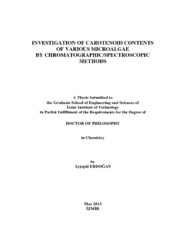Please use this identifier to cite or link to this item:
https://hdl.handle.net/11147/2960Full metadata record
| DC Field | Value | Language |
|---|---|---|
| dc.contributor.advisor | Eroğlu, Ahmet Emin | en |
| dc.contributor.author | Erdoğan, Ayşegül | - |
| dc.date.accessioned | 2014-07-22T13:48:40Z | - |
| dc.date.available | 2014-07-22T13:48:40Z | - |
| dc.date.issued | 2013 | en |
| dc.identifier.uri | http://hdl.handle.net/11147/2960 | - |
| dc.description | Thesis (Doctoral)--İzmir Institute of Technology, Chemistry, İzmir, 2013 | en |
| dc.description | Includes bibliographical references (leaves: 86-93) | en |
| dc.description | Text in English; Abstract: Turkish and English | en |
| dc.description | xii, 93 leaves | en |
| dc.description | Full text release delayed at author's request until 2016.06.26 | en |
| dc.description.abstract | Microalgae are the most important energy sources among microorganisms. Carotenoids, as important pigments and antioxidants, are produced by microalgae and are used both for health purposes and as natural colorants. There has been considerable research for the development, identification and determination of new strains of organisms to produce a variety of carotenoids. New methods for the isolation of carotenoids should be developed also for analytical purposes. This study aimed the biosynthesis of carotenoids from microalgae, (Prochlorococcus sp., Scenedesmus protuberans and Nitzschia sp.) their identification and quantification. It is known that some types of microalgae can produce high amount of carotenoids under different stress conditions while some others can produce carotenoids only under stress. For this purpose, cultivation conditions were optimized for the production of new or high value of carotenoids in the selected microalgal strains. Freeze-dried microalgae were extracted using different organic solvents and their carotenoid contents were investigated by high performance liquid chromatography (HPLC) and other chromatographic techniques such as liquid chromatography-mass spectrometry (LC-MS); in addition to (UV-VIS) spectroscopy. In green microalgae lutein (2.54 mg/g for Prochlorococcus sp. and 2.45 mg/g for Scenedesmus protuberans) is the most abundant carotenoid. On the other hand, in brown microalga fucoxanthin (6.58 mg/g for Nitzschia sp.) is the highly accumulated carotenoid. Under stress conditions, many microalgae alter their biosynthetic pathways for the formation and accumulation of carotenoids. Therefore, the effect of different nitrogen sources, oxidative stress conditions and different light sources on lutein content in green microalgae and on fucoxanthin content in brown microalga were investigated. | en |
| dc.language.iso | en | en_US |
| dc.publisher | Izmir Institute of Technology | en_US |
| dc.rights | info:eu-repo/semantics/embargoedAccess | en_US |
| dc.subject.lcsh | Microalgae--Biotechnology | en |
| dc.subject.lcsh | Carotenoids | en |
| dc.subject.lcsh | Green algae | en |
| dc.subject.lcsh | Mass spectrometry | en |
| dc.subject.lcsh | Liquid chromatography | en |
| dc.title | Investigation of carotenoid contents of various microalgae by chromatographis/spectroscopic methods | en_US |
| dc.type | Doctoral Thesis | en_US |
| dc.institutionauthor | Erdoğan, Ayşegül | - |
| dc.department | Thesis (Doctoral)--İzmir Institute of Technology, Chemistry | en_US |
| dc.relation.publicationcategory | Tez | en_US |
| item.fulltext | With Fulltext | - |
| item.grantfulltext | open | - |
| item.languageiso639-1 | en | - |
| item.openairecristype | http://purl.org/coar/resource_type/c_18cf | - |
| item.cerifentitytype | Publications | - |
| item.openairetype | Doctoral Thesis | - |
| Appears in Collections: | Phd Degree / Doktora | |
Files in This Item:
| File | Description | Size | Format | |
|---|---|---|---|---|
| 10004772.pdf | DoctoralThesis | 1.93 MB | Adobe PDF |  View/Open |
CORE Recommender
Page view(s)
204
checked on Nov 18, 2024
Download(s)
186
checked on Nov 18, 2024
Google ScholarTM
Check
Items in GCRIS Repository are protected by copyright, with all rights reserved, unless otherwise indicated.